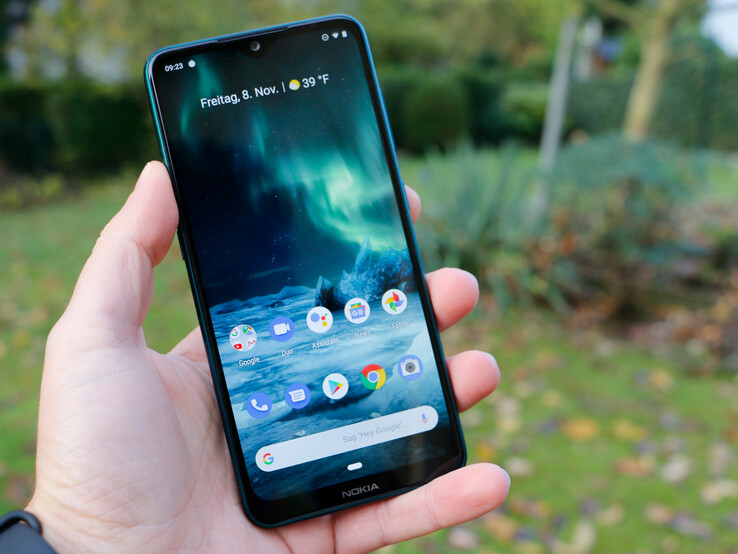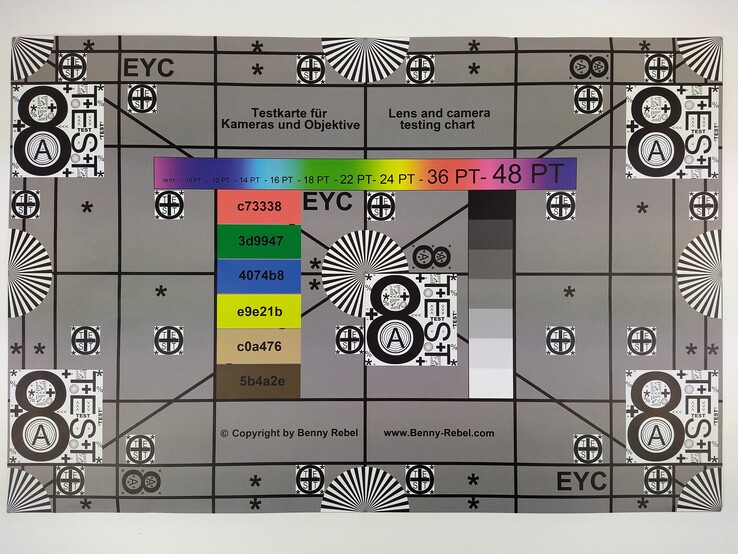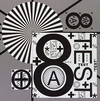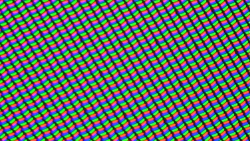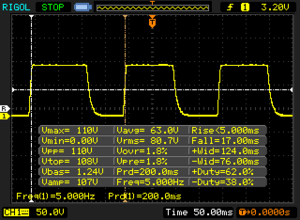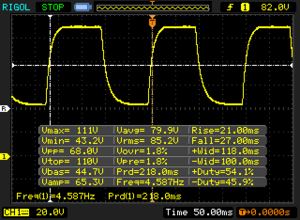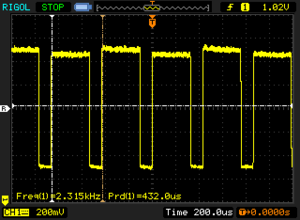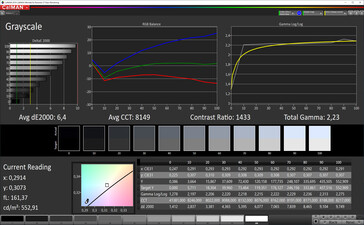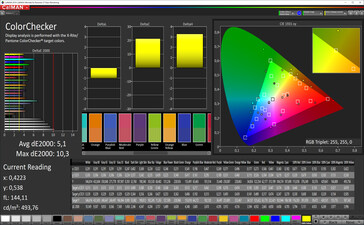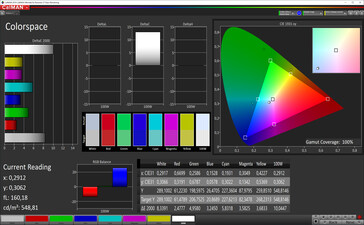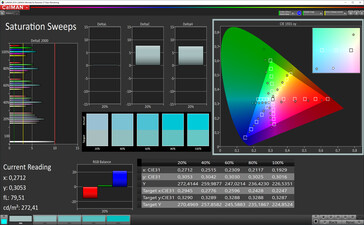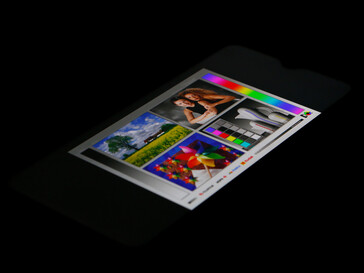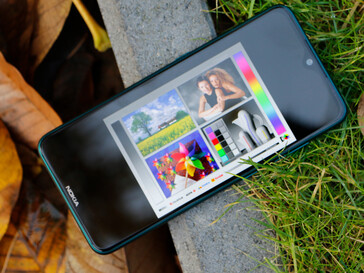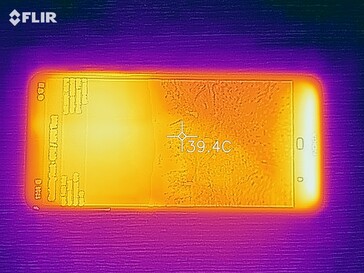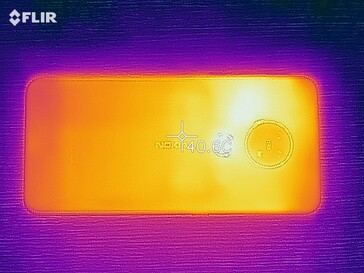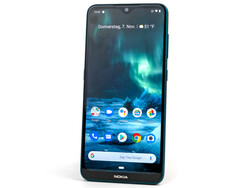Nokia 7.2 Review - Good smartphone with errors in detail
Comparison Units
Bewertung | Rating Version | Datum | Modell | Gewicht | Laufwerk | Groesse | Aufloesung | Preis ab |
|---|---|---|---|---|---|---|---|---|
| 78.6 % v7 (old) | v7 (old) | 11 / 2019 | Nokia 7.2 SD 660, Adreno 512 | 180 g | 64 GB eMMC Flash | 6.30" | 2340x1080 | |
| 79.8 % v7 (old) | v7 (old) | 04 / 2019 | Samsung Galaxy A50 Exynos 9610, Mali-G72 MP3 | 166 g | 128 GB UFS 2.1 Flash | 6.40" | 2340x1080 | |
| 78.3 % v7 (old) | v7 (old) | 05 / 2019 | Huawei P30 Lite Kirin 710, Mali-G51 MP4 | 159 g | 128 GB eMMC Flash | 6.15" | 2312x1080 | |
| 79.2 % v7 (old) | v7 (old) | 11 / 2019 | Xiaomi Redmi Note 8 SD 665, Adreno 610 | 190 g | 128 GB eMMC Flash | 6.30" | 2340x1080 |
Case, Equipment and Operation
We really like the quality of Nokia 7.2's workmanship. The gap dimensions fit perfectly and the panel is comparatively insensitive to pressure. Moreover, our green test device is really chic and the matt glass back is less susceptible to fingerprints.
The operating system is Android 9.0 Pie. As the Nokia 7.2 also uses Android One, regular updates can be expected for two years, Android 10 will be distributed until the beginning of 2020.
The mobile radio frequency coverage is completely sufficient for the European area and HMD Global provides the Nokia mobile phone with a fast WLAN module, which shows stable transmission rates in the test.
The microSD card slot officially supports media up to a size of 512 GB, but does not support the exFAT file system. The USB 2.0 port (Type-C) supports USB OTG and Power Delivery, but cannot be used for image output. NFC, Bluetooth 5.0 and an analogue radio receiver make the equipment almost complete. The Nokia 7.2 is also advanced in GNSS support and can process single-band signals from GPS, Glonass, BeiDou, QZSS and Galileo.
The physical keys have a little play in the case, but clearly defined pressure points. There's also a dedicated button for the Google Assistant and a fingerprint sensor on the back that does its job quite reliably and takes the user straight to the surface. Alternatively, less reliable 2D face recognition is also available.
| Networking | |
| iperf3 transmit AX12 | |
| Xiaomi Redmi Note 8 | |
| Nokia 7.2 | |
| Samsung Galaxy A50 | |
| Huawei P30 Lite | |
| iperf3 receive AX12 | |
| Nokia 7.2 | |
| Xiaomi Redmi Note 8 | |
| Samsung Galaxy A50 | |
| Huawei P30 Lite | |
Cameras - Triple camera in Nokia 7.2
In addition to the main sensor (48 MP, Samsung Isocell-GM1), the Nokia 7.2's triple camera offers a 5 MP lens for collecting depth information and an 8 MP ultra-wide angle (118 degrees). In daylight, balanced shots are possible, which convince with a good dynamic range, but are somewhat oversharpened. In low ambient light, the shots look too cool and details are blurred.
At best, videos are recorded in Ultra HD (30 FPS) and supported by OZO Audio. The ultra wide angle can also be used without restrictions, but delivers a considerably worse picture quality. It is not possible to switch between the lenses during recording.
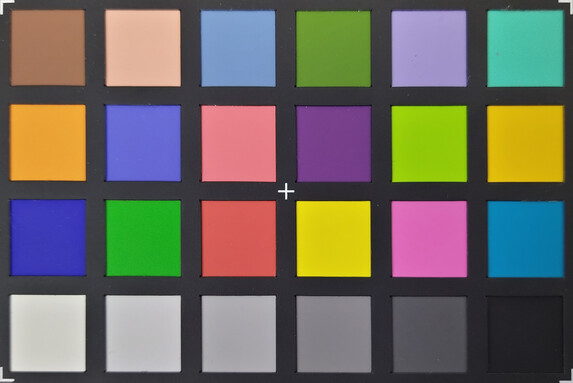
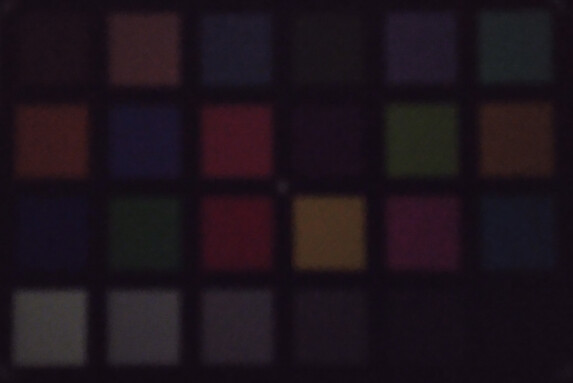
Display - Good IPS in Nokia phone, but with PWM
The Nokia 7.2's 6.3-inch IPS display offers high pixel density. The brightness of the panel is also high, the illumination is even and the color display is improved compared to the predecessor. Unfortunately Nokia again uses pulse width modulation for brightness control, which won't bother most users due to the high frequency, but especially sensitive people could still show complaints.
The HMD smartphone does really well outdoors, only the reflective display makes it difficult to read on sunny days.
| |||||||||||||||||||||||||
Brightness Distribution: 92 %
Center on Battery: 604 cd/m²
Contrast: 1510:1 (Black: 0.4 cd/m²)
ΔE ColorChecker Calman: 5.1 | ∀{0.5-29.43 Ø4.78}
ΔE Greyscale Calman: 6.4 | ∀{0.09-98 Ø5}
100% sRGB (Calman 2D)
Gamma: 2.23
CCT: 8149 K
| Nokia 7.2 IPS, 2340x1080, 6.3" | Nokia 7.1 IPS, 2280x1080, 5.8" | Samsung Galaxy A50 AMOLED, 2340x1080, 6.4" | Huawei P30 Lite IPS LCD, 2312x1080, 6.2" | Xiaomi Redmi Note 8 IPS, 2340x1080, 6.3" | |
|---|---|---|---|---|---|
| Response Times | 13% | 78% | -28% | -5% | |
| Response Time Grey 50% / Grey 80% * (ms) | 48 ? | 43.6 ? 9% | 8 ? 83% | 54.4 ? -13% | 49.6 ? -3% |
| Response Time Black / White * (ms) | 22 ? | 18.4 ? 16% | 6 ? 73% | 31.2 ? -42% | 23.6 ? -7% |
| PWM Frequency (Hz) | 2315 ? | 2315 ? | 119 | ||
| Screen | -18% | 22% | 7% | 23% | |
| Brightness middle (cd/m²) | 604 | 577 -4% | 644 7% | 451 -25% | 656 9% |
| Brightness (cd/m²) | 593 | 550 -7% | 628 6% | 430 -27% | 643 8% |
| Brightness Distribution (%) | 92 | 91 -1% | 91 -1% | 90 -2% | 95 3% |
| Black Level * (cd/m²) | 0.4 | 0.36 10% | 0.55 -38% | 0.54 -35% | |
| Contrast (:1) | 1510 | 1603 6% | 820 -46% | 1215 -20% | |
| Colorchecker dE 2000 * | 5.1 | 7.4 -45% | 2.64 48% | 1.4 73% | 1.1 78% |
| Colorchecker dE 2000 max. * | 10.3 | 15 -46% | 9.23 10% | 4.4 57% | 2.4 77% |
| Greyscale dE 2000 * | 6.4 | 10.2 -59% | 2.5 61% | 2.5 61% | 2.2 66% |
| Gamma | 2.23 99% | 2.29 96% | 2.024 109% | 2.22 99% | 2.2 100% |
| CCT | 8149 80% | 9657 67% | 6649 98% | 6422 101% | 6263 104% |
| Total Average (Program / Settings) | -3% /
-12% | 50% /
36% | -11% /
-0% | 9% /
18% |
* ... smaller is better
Display Response Times
| ↔ Response Time Black to White | ||
|---|---|---|
| 22 ms ... rise ↗ and fall ↘ combined | ↗ 5 ms rise | |
| ↘ 17 ms fall | ||
| The screen shows good response rates in our tests, but may be too slow for competitive gamers. In comparison, all tested devices range from 0.1 (minimum) to 240 (maximum) ms. » 47 % of all devices are better. This means that the measured response time is similar to the average of all tested devices (20.2 ms). | ||
| ↔ Response Time 50% Grey to 80% Grey | ||
| 48 ms ... rise ↗ and fall ↘ combined | ↗ 21 ms rise | |
| ↘ 27 ms fall | ||
| The screen shows slow response rates in our tests and will be unsatisfactory for gamers. In comparison, all tested devices range from 0.165 (minimum) to 636 (maximum) ms. » 82 % of all devices are better. This means that the measured response time is worse than the average of all tested devices (31.6 ms). | ||
Screen Flickering / PWM (Pulse-Width Modulation)
| Screen flickering / PWM detected | 2315 Hz | ≤ 19 % brightness setting | |
The display backlight flickers at 2315 Hz (worst case, e.g., utilizing PWM) Flickering detected at a brightness setting of 19 % and below. There should be no flickering or PWM above this brightness setting. The frequency of 2315 Hz is quite high, so most users sensitive to PWM should not notice any flickering. In comparison: 53 % of all tested devices do not use PWM to dim the display. If PWM was detected, an average of 8108 (minimum: 5 - maximum: 343500) Hz was measured. | |||
Performance, Emissions and Battery life
The Nokia 7.2 is powered by the meanwhile aging Snapdragon 660, which is supported by 4 GB RAM. The combo provides a smooth system performance, with which only rarely smaller jerkers are recognizable. Those who like to use elaborate 3D games will have to reduce the level of detail if necessary. The memory speed is good, only when writing small data blocks the Nokia phone weakens a little.
The surface temperatures of the Nokia 7.2 are harmless at all times and the included power supply barely warms up. Under constant load, the smartphone just gets lukewarm.
The loudspeaker at the lower edge delivers a solid sound in the medium volume range. If you turn the smartphone up to the limit, you get a rather tinny sound that can't inspire much. The audio jack offers an alternative, if you prefer wireless headphones or speakers, you can use high-resolution audio codecs such as aptX HD or LDAC.
The battery life of the 3,500 mAh rechargeable battery will get a user through the day well, but there won't be many reserves left.
| PCMark for Android | |
| Work performance score (sort by value) | |
| Samsung Galaxy A50 | |
| Huawei P30 Lite | |
| Xiaomi Redmi Note 8 | |
| Average Qualcomm Snapdragon 660 (6274 - 7026, n=11) | |
| Work 2.0 performance score (sort by value) | |
| Nokia 7.2 | |
| Samsung Galaxy A50 | |
| Huawei P30 Lite | |
| Xiaomi Redmi Note 8 | |
| Average Qualcomm Snapdragon 660 (5789 - 6426, n=13) | |
| GFXBench | |
| on screen Aztec Ruins Normal Tier Onscreen (sort by value) | |
| Nokia 7.2 | |
| Samsung Galaxy A50 | |
| Huawei P30 Lite | |
| Xiaomi Redmi Note 8 | |
| Average Qualcomm Snapdragon 660 (7.5 - 15, n=9) | |
| Average of class Smartphone (6.2 - 166, n=209, last 2 years) | |
| 1920x1080 Aztec Ruins Normal Tier Offscreen (sort by value) | |
| Nokia 7.2 | |
| Samsung Galaxy A50 | |
| Huawei P30 Lite | |
| Xiaomi Redmi Note 8 | |
| Average Qualcomm Snapdragon 660 (7.9 - 8.8, n=9) | |
| Average of class Smartphone (3.4 - 367, n=209, last 2 years) | |
| on screen Aztec Ruins High Tier Onscreen (sort by value) | |
| Nokia 7.2 | |
| Samsung Galaxy A50 | |
| Huawei P30 Lite | |
| Xiaomi Redmi Note 8 | |
| Average Qualcomm Snapdragon 660 (4.7 - 10, n=9) | |
| Average of class Smartphone (0.85 - 144, n=210, last 2 years) | |
| 2560x1440 Aztec Ruins High Tier Offscreen (sort by value) | |
| Nokia 7.2 | |
| Samsung Galaxy A50 | |
| Huawei P30 Lite | |
| Xiaomi Redmi Note 8 | |
| Average Qualcomm Snapdragon 660 (3 - 3.3, n=9) | |
| Average of class Smartphone (1.2 - 146, n=209, last 2 years) | |
| Nokia 7.2 | Samsung Galaxy A50 | Huawei P30 Lite | Xiaomi Redmi Note 8 | Average 64 GB eMMC Flash | Average of class Smartphone | |
|---|---|---|---|---|---|---|
| AndroBench 3-5 | 23% | 90% | 93% | 20% | 1105% | |
| Sequential Read 256KB (MB/s) | 290.8 | 507 74% | 293.2 1% | 297.6 2% | 277 ? -5% | 2228 ? 666% |
| Sequential Write 256KB (MB/s) | 161.4 | 192.1 19% | 158.6 -2% | 160.5 -1% | 178.4 ? 11% | 1852 ? 1047% |
| Random Read 4KB (MB/s) | 79.6 | 98.9 24% | 71.6 -10% | 84.8 7% | 60.7 ? -24% | 296 ? 272% |
| Random Write 4KB (MB/s) | 13.38 | 18.2 36% | 87.3 552% | 91.2 582% | 33.8 ? 153% | 339 ? 2434% |
| Sequential Read 256KB SDCard (MB/s) | 83.3 ? | 73.9 ? -11% | 76.8 ? -8% | 71.6 ? -14% | 77.4 ? -7% | |
| Sequential Write 256KB SDCard (MB/s) | 64 ? | 60.7 ? -5% | 67.8 ? 6% | 52.8 ? -17% | 58.3 ? -9% |
Temperature
(+) The maximum temperature on the upper side is 37 °C / 99 F, compared to the average of 35.2 °C / 95 F, ranging from 21.9 to 247 °C for the class Smartphone.
(+) The bottom heats up to a maximum of 35.3 °C / 96 F, compared to the average of 34 °C / 93 F
(+) In idle usage, the average temperature for the upper side is 28.3 °C / 83 F, compared to the device average of 32.9 °C / 91 F.
Loudspeakers
Nokia 7.2 audio analysis
(+) | speakers can play relatively loud (85 dB)
Bass 100 - 315 Hz
(-) | nearly no bass - on average 33.3% lower than median
(±) | linearity of bass is average (10.4% delta to prev. frequency)
Mids 400 - 2000 Hz
(±) | reduced mids - on average 6.1% lower than median
(+) | mids are linear (6.5% delta to prev. frequency)
Highs 2 - 16 kHz
(±) | higher highs - on average 6.8% higher than median
(+) | highs are linear (4.6% delta to prev. frequency)
Overall 100 - 16.000 Hz
(±) | linearity of overall sound is average (26.9% difference to median)
Compared to same class
» 69% of all tested devices in this class were better, 5% similar, 26% worse
» The best had a delta of 11%, average was 35%, worst was 134%
Compared to all devices tested
» 82% of all tested devices were better, 4% similar, 14% worse
» The best had a delta of 4%, average was 24%, worst was 134%
Samsung Galaxy A50 audio analysis
(+) | speakers can play relatively loud (85 dB)
Bass 100 - 315 Hz
(-) | nearly no bass - on average 73.9% lower than median
(+) | bass is linear (0% delta to prev. frequency)
Mids 400 - 2000 Hz
(-) | nearly no mids - on average 73.9% lower than median
(+) | mids are linear (0% delta to prev. frequency)
Highs 2 - 16 kHz
(-) | nearly no highs - on average 73.9% lower than median
(+) | highs are linear (0% delta to prev. frequency)
Overall 100 - 16.000 Hz
(-) | overall sound is not linear (119.9% difference to median)
Compared to same class
» 89% of all tested devices in this class were better, 8% similar, 3% worse
» The best had a delta of 11%, average was 35%, worst was 134%
Compared to all devices tested
» 97% of all tested devices were better, 3% similar, 1% worse
» The best had a delta of 4%, average was 24%, worst was 134%
Battery life
| Nokia 7.2 3500 mAh | Samsung Galaxy A50 4000 mAh | Huawei P30 Lite 3340 mAh | Xiaomi Redmi Note 8 4000 mAh | Average of class Smartphone | |
|---|---|---|---|---|---|
| Battery Runtime | |||||
| WiFi Websurfing (h) | 9.5 | 11.7 23% | 8.6 -9% | 13.7 44% | 19.3 ? 103% |
Pros
Cons
Verdict - Weaknesses in detail
HMD Global does a lot right with the Nokia 7.2, but the smartphone shows some weaknesses in detail in some areas. There's a full dual SIM option plus an extra space for a microSD card, but the latter doesn't support exFAT. The display is both bright and high-contrast, but uses PWM. The SoC provides a smooth system performance, but is already three years old. Especially in view of the upcoming updates, the use of such an old processor is questionable.
The camera also performs well in the test, as long as there is enough light. In addition, it exaggerates the optics a little with the resharpening. The battery is only sufficiently dimensioned, but many competitors like the Galaxy A50 or the Wiko View 3 Pro already rely on 4,000 mAh and this is noticeable in everyday life.
The Nokia 7.2 offers pure Android pleasure and regular updates.
Nevertheless, the Nokia 7.2 is a very successful further development compared to its predecessor, because a lot has happened especially in terms of battery life and the memory has also been spiced up considerably. And for those who value a pure Android experience, there is no way around the Nokia phone in this price range, as it is equipped with Android One.
Nokia 7.2
- 11/14/2019 v7 (old)
Daniel Schmidt




